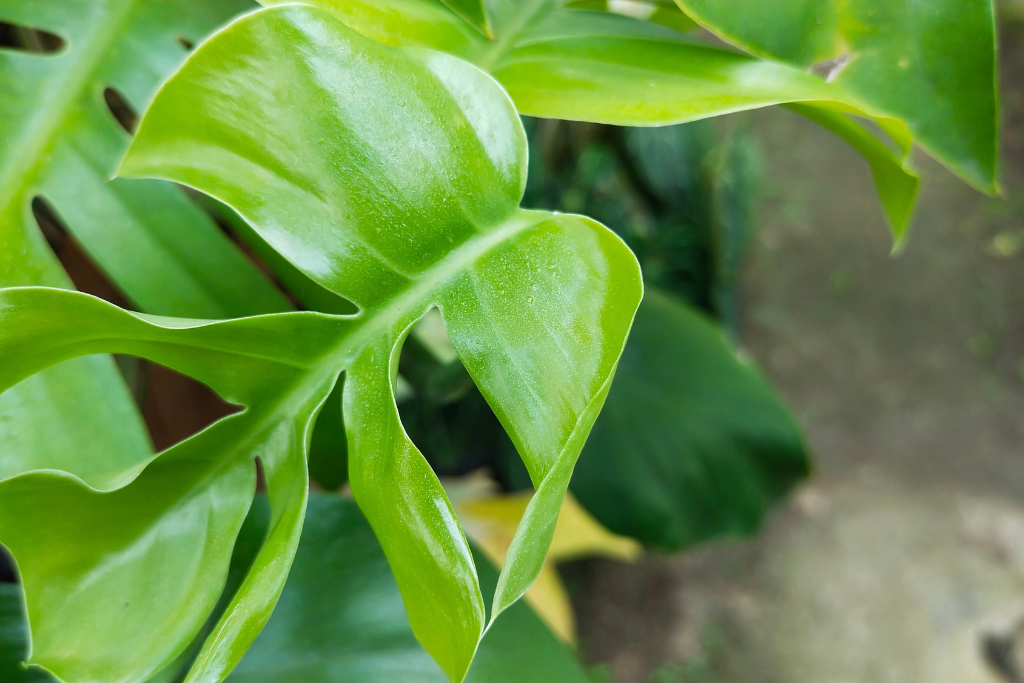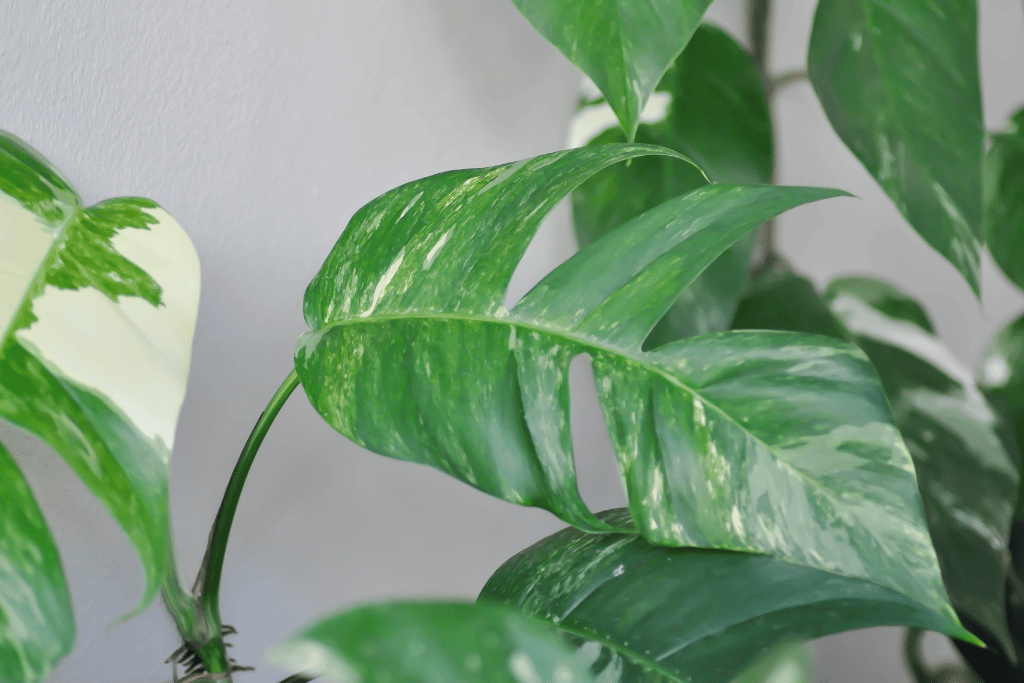
With its interesting leaves, it’s no surprise that the dragon tail plant is one of the most popular houseplants to keep. They have a reputation for being both beautiful and easy to care for. Native to the Solomon Islands, they are part of the Araceae family, which also includes other popular houseplants you might’ve heard of, such as the Monstera deliciosa and Philodendron.
What Does Dragon Tail Look Like?
Interestingly, the dragon tail plant actually lives up to its name. They have glossy and elongated leaves which resemble the tail of a dragon, giving them their common name. The leaves are pretty unique, with a central stem and several leaflets which branch off in a feather-like pattern. Growing up to around 12 inches long with a vibrant green color, the leaves are some of the most beautiful you’ll see on a houseplant!
Taking Care of Dragon Tail

Dragon’s tail can be a hit and a miss for some people – they prefer warmer temperatures of around 18-29C (65-85F) and plenty of humidity, which some people aren’t able to provide. Though they may be beautiful, I wouldn’t recommend getting one unless you’re optimistic that you’ll be able to keep it alive. Instead, why not opt for other houseplants, like orchids?
Light & Temperature
Coming from a tropical environment, the dragon tail plant takes after its habitat. It’s a tropical plant which thrives in humid and warm climates, preferring bright but indirect light. This makes it an excellent option for indoor spaces which receive a lot of natural light but not direct sunlight. Like many other houseplants, direct sunlight will cause the leaves to scorch and become sunburnt, turning them brown.
In terms of temperature, the dragon tail plant prefers to be kept on the warmer side, at around 18-29C (65-85F) and won’t do well in temperatures that go below 15C (60F). So, it’s probably wise to keep your dragon tail plant in a room that receives a good amount of light but is insulated well, making sure that it’s always warm.
Watering & Soil
Like most other houseplants, the dragon’s tail plant prefers well-draining soil, which is constantly moist but not to the point where it’s waterlogged. You’ll find that they only need watering once weekly, but I’m not particularly eager to water on a schedule. I check the soil’s moisture frequently, simply poking my finger an inch deep into the soil to see if it needs watering. If it’s soggy, I’ll hold off on watering until the soil dries out slightly – make sure you never let the soil completely dry out, though.
When watering, I also like to mist the leaves of my dragon tail plant too. This will help it grow and be more comfortable, increasing the humidity around the plant. If you’d like to provide it with more humidity, you can use drip trays with grit which you water every so often, which should increase the humidity. You could also use humidifiers, which might be unsuitable for most people.
Fertilizing
Feeding your houseplants is very important – most people don’t actually realize how important it is. If you don’t feed your houseplants at all, they’ll start to suffer over time and won’t have the nutrients to put on growth or put out any flowers if they do.
The dragon’s tail plant will benefit greatly from regular fertilization in the growing season, typically between spring and autumn. It would be best if you were fertilizing it every 2-3 weeks with a balanced fertilizer, being careful not to over-fertilize; otherwise, this could lead to damaged foliage and burned roots.
If you think you might have over-fertilized your dragon’s tail plant, it’s best to try and drain out as much fertilizer as possible. From experience, I’ve found that the best way to do this is to submerge the plant underwater completely for a bit. This will help to drain out as much fertilizer as possible – you can also water it thoroughly after you do this. I don’t recommend watering it constantly after this, though; otherwise, this will promote overwatering and cause root rot.
Common Problems
Like almost every other houseplant, the dragon’s tail plant is also susceptible to pests and diseases. There are a few common issues you should look out for – spider mites, scale insects and mealybugs.
With dragon’s tail and all of your other plants, it’s always best to regularly look over the leaves, stems and roots to ensure you find any signs of trouble before they become worse. Treating infestations early will help to control them, preventing damage from coming to your plant and ensuring its health.
Most of the pests can be treated with pesticide applications, but I like to use neem oil. It’s an environmentally friendly, organic solution that is fantastic at treating pests, and you can usually find it relatively cheap online.
Propagating Dragon’s Tail

Dragon’s tail can grow quite quickly, covering large spaces in a relatively short amount of time. It’s a vining plant which can grow up to 6 feet long, which makes it excellent for trailing down bookshelves or hanging planters.
Luckily for us, dragon’s tail is easy to propagate. It’s an excellent choice for those who love getting more and more plants, which you can share with your friends and family or help to expand your growing collection of plants further.
The most used method of propagation for dragon’s tail is stem cuttings. Take a 4-6 inch section of stem, placing it in water until it begins to root. Once these roots have become established, you can then pot it up in a free-draining mix of soil! It’s that easy.
Final Thoughts
Dragon’s tail plant is a beautiful houseplant, perfect for plant enthusiasts with all types of experience. With its unique and striking foliage, easy propagation and rapid growth, it’s not surprising that it’s a popular choice for many plant lovers. As long as you’re able to provide the right growing conditions and regularly check for diseases and pests, your dragon tail will thrive.
Frequently Asked Questions (FAQ)
What are the benefits of dragon tail plant?
In China, the dragon tail plant is used to treat dysentery, fractures and rheumatism. They use the decoction of the leaves to treat malaria, and the juice from the stems can be mixed with water and consumed for dislocations, joint problems and fractures. Decoction of leaves can also be used as a mouthwash and to treat tooth abscesses and gum inflammations. Make sure to research this intensively before trying any of these yourself, though!
Where should I put my dragon tail plant?
As mentioned in the article, your dragon tail plant will benefit from being kept somewhere that gets bright and indirect light, with warm temperatures and a good amount of humidity. Make sure that it’s not exposed to direct sunlight; otherwise, you could risk burning the leaves and turning them brown, causing them to die. It’s a good idea to grow them in bathrooms or kitchens; however, you need to make sure these rooms get a good amount of light.
Is the dragon tail plant poisonous?
Yes, it is! All parts of the dragon tail plant are poisonous, so make sure that neither you nor any animals you have ingest any parts of it. It doesn’t look very appetizing anyway… If any of your pets ingest it, it’s best to take them to a vet as soon as possible and keep a log of any symptoms they exhibit, which should help the vet treat them as best as possible.
Is dragon tail an indoor plant?
Dragon tail is native to many places, such as south-east Asia, Australia and French Polynesia. Though, in colder climates, dragon tail are typically grown as indoor plants. In the wild, they grow along the forest floor of tropical and subtropical rainforests – especially in the Solomon Island rainforests. Therefore, this is why we give them warm and humid environments.



